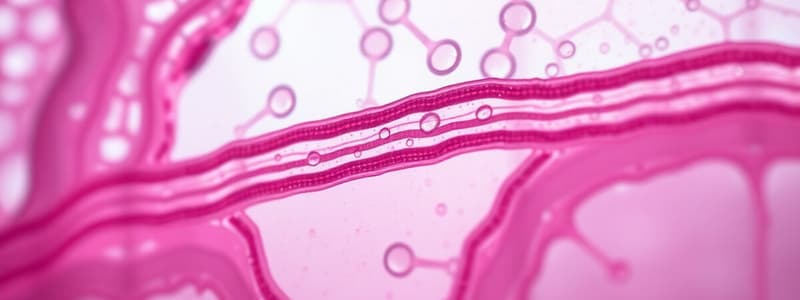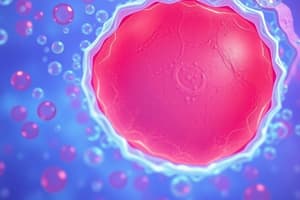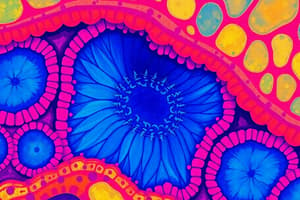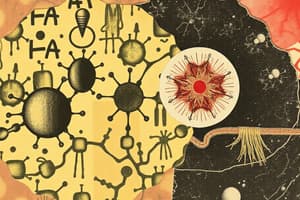Podcast
Questions and Answers
What is the primary function of the Fascia Adherens in cardiac muscle?
What is the primary function of the Fascia Adherens in cardiac muscle?
- To regulate vascular permeability
- To create a strong seal between cells
- To facilitate muscle contraction (correct)
- To provide structural support
Which type of epithelial gland releases all of its cytoplasmic content into the secretion?
Which type of epithelial gland releases all of its cytoplasmic content into the secretion?
- Apocrine
- Compound
- Merocrine
- Holocrine (correct)
Identify the epithelial structure known for secreting mucus.
Identify the epithelial structure known for secreting mucus.
- Mucus-secreting cell (correct)
- Intestinal crypt
- Simple tubular gland
- Serous-secreting cell
What type of secretion involves the release of a portion of the cell's cytoplasm?
What type of secretion involves the release of a portion of the cell's cytoplasm?
Intermediate filaments found in epithelial tissues are primarily composed of which protein?
Intermediate filaments found in epithelial tissues are primarily composed of which protein?
The zonula adherens is a type of structure primarily associated with which tissue type?
The zonula adherens is a type of structure primarily associated with which tissue type?
Which classification of epithelial glands is characterized by continuous secretion without losing cellular material?
Which classification of epithelial glands is characterized by continuous secretion without losing cellular material?
In the context of epithelial cell modifications, what characterizes the lateral membrane modifications?
In the context of epithelial cell modifications, what characterizes the lateral membrane modifications?
Which of the following structures is NOT related to the secretion process of epithelial glands?
Which of the following structures is NOT related to the secretion process of epithelial glands?
What is the function of the crypts of Lieberkühn?
What is the function of the crypts of Lieberkühn?
Flashcards
What is Fascia Adherens?
What is Fascia Adherens?
A specialized type of zonula adherens found in cardiac muscle cells.
What is a Macula Adherens or Desmosome?
What is a Macula Adherens or Desmosome?
A type of cell junction that provides strong adhesion between epithelial cells. It is characterized by the presence of intermediate filaments (keratin) that attach to desmosomal plaques, which are linked to the cytoskeleton.
What are epithelial glands?
What are epithelial glands?
Epithelial glands are groups of epithelial cells specialized for secretion. They can be classified based on their mode of secretion or the type of secretion they produce.
What is Merocrine secretion?
What is Merocrine secretion?
Signup and view all the flashcards
What is Holocrine secretion?
What is Holocrine secretion?
Signup and view all the flashcards
What is Apocrine secretion?
What is Apocrine secretion?
Signup and view all the flashcards
How are glands classified based on their secretion type?
How are glands classified based on their secretion type?
Signup and view all the flashcards
What is a simple tubular gland?
What is a simple tubular gland?
Signup and view all the flashcards
What is a mucus-secreting cell?
What is a mucus-secreting cell?
Signup and view all the flashcards
What is a serous-secreting cell?
What is a serous-secreting cell?
Signup and view all the flashcards
Study Notes
Epithelial Tissue Part 3
- This presentation covers epithelial cell surface modifications, specifically basolateral, lateral, and basal surfaces, and glands.
- The presenter is Dr. Mallika Indran, BDS, PhD, FICCDE, from Saba University School of Medicine.
- Office hours are 12-2:00 pm, Monday-Friday, and appointments are available.
Basolateral Surface Specialization
- Basolateral surfaces exhibit specializations like lateral folds and basal folds, crucial for rapid fluid transport.
- These folds are prominent in cells like those in the intestines and kidneys, enhancing their surface area for efficient fluid absorption or secretion.
Lateral folds
- Lateral folds are created by infoldings of the cell membrane to increase surface area.
- This significant increase in the lateral surface area is crucial for transporting fluids rapidly, such as in the intestines and kidneys.
- Water enters cells apically and then leaves the cells at the lateral surface.
- Water movement is driven by osmotic pressure following the active transport of sodium ions across the lateral plasma membrane.
Basal Surface Specialization
- Basal folds are characteristic of cells that actively transport molecules.
- Mitochondria, providing energy for active transport, are concentrated in relation to the folds.
- The folds and mitochondria's orientation are essential for coordinated function, crucial in cells like those of the kidney and salivary glands proximal and distal tubules.
Cell-to-Cell Adhesions
-
Epithelial cells are joined via a junctional complex, consisting of:
- Occluding junctions (tight junctions): sealing the space between cells
- Anchoring junctions: providing mechanical stability to cells
- Communicating junctions (gap junctions): allowing intercellular communication
-
Occluding junctions (zonula occludens), also known as tight junctions, form a complete belt around each cell, forming a diffusion barrier, and preventing the passage of molecules between cells.
Anchoring Junctions (two types)
-
Zonula Adherens: Continuous band-like adhesion that surrounds the cell and joins it to neighboring cells. Formed by the binding of transmembrane proteins (cadherins), especially E-cadherins. E-cadherins are crucial for cell-cell adhesion and known to suppress tumor development.
-
Macula Adherens or Desmosomes: Localized spot adhesion, located at multiple sites on the lateral surfaces of adjoining cells, providing strong attachment. Formed via the binding of transmembrane proteins like desmogleins, desmocollins, and cytoplasmic proteins like plakoglobins and desmoplakins, anchoring to intermediate filaments (e.g. keratin).
-
Fascia adherens is the zonula adherens in cardiac muscle tissues.
Hemidesmosomes
- Half-desmosomes are found on the basal surface of epithelial cells.
- They exhibit intracellular attachment plaques, composed of proteins like plectin and BP 230, that interact with the basal lamina.
- BP 230 and other proteins attach intermediate filaments to the attachment plaques.
- Hemidesmosomes connect the cell to the extracellular matrix (basal lamina).
Focal Adhesions
- Focal adhesions transmit signals from the extracellular environment to the interior of the cell, linking the actin filaments in the cytoplasm of the cell to the extracellular matrix.
Gap Junctions or Nexuses
- Gap junctions or nexuses are channels on the lateral surfaces of adjoining cells that allow for direct passage of signaling molecules between cells.
- They are made up of connexons, consisting of six connexin proteins, to create a hydrophilic channel for communication and ion exchange between cells.
Epithelial Glands
- Glands are organized collections of secretory epithelial cells.
- They form during epithelial development via proliferation and project into the underlying connective tissue.
- There are two main types of glands:
- Exocrine glands, which retain continuity with the surface via ducts.
- Endocrine glands, losing continuity with the surface via duct degeneration and secrete into the bloodstream.
Classification of Exocrine Glands
-
Unicellular glands, like goblet cells, release their products directly onto the epithelial surface. They synthesize and secrete mucus to maintain the protective mucosal barriers. Goblet cells are found in the intestinal and respiratory tracts
-
Multicellular glands, exhibiting diversity in classification based on duct structure (simple or branched), shape of secretory units (tubular, alveolar/acinar), and secretion type (serous, mucous, or mixed).
-
Mode of secretion is key: Merocrine (most common exocytosis), Holocrine (whole cell rupturing), and Apocrine secretion (loss of apical cytoplasm).
-
The different classifications of glands (e.g., serous, mucous, and mixed glands) are based on the type of secretion they produce. For example, serous glands produce protein secretions, mucous glands produce mucus, and mixed glands produce both.
Useful Definitions
- Parenchyma: Functional tissue of an organ
- Stroma: Supporting connective tissue of an organ.
Additional Notes
- Images with labels are used to visualize specific structures and their locations in cells.
- This presentation outlines the diverse mechanisms and structures facilitating cell-to-cell communication and anchoring within epithelial tissues.
Studying That Suits You
Use AI to generate personalized quizzes and flashcards to suit your learning preferences.




